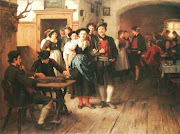This portrait of Margaret of Spain, the Holy Roman Empress, in mourning black in 1666, recalls to us that mourning was a solemn duty in times past as a way of reminding Christians to pray for the recently dead.
Praying for the dead is, for those who have forgotten it, a grave duty for all Catholic Christians and one of the Spiritual Works of Mercy.
The purpose is to deliver one's loved ones out of the painful, suffering process of purgation that all but the most perfect must endure after death before they are sufficiently pure and holy to be ushered into the presence of Almighty God who is all love. No taint of self-love must remain to those who come before God.
Consider an analogy: when one awakes, or has been in a dark place, it takes a little while for the eyes to adjust to the light which is painful to behold until the adjustment is made. So with us sinners who are being prepared to enjoy the supreme joy of the presence of God - we have to adjust to the brilliance of His perfect light before we can see Him clearly.
Now this process can, by reason of the Communion of all the Faithful with the Saints in heaven, be hastened by the prayers of the Faithful here below where we are still ourselves suffering and gaining grace for ourselves and for others. Once we are in Purgatory we are being purged and can no longer merit grace for others. So we must do so here below whilst we have the time.
Now this duty is easily forgotten in a busy world and so we wear mourning to remind us to pray regularly throughout the day and night for our dead.
We do this by wearing black (called Grand Deuil by the French) - save for some Catholic Queens who wear Deuil Blanc, that is, white. Queen Fabiola did so at the Funeral of her late husband, King Baudouin of Belgium.
The length of mourning depended on your relationship to the deceased. The different periods of mourning dictated by society were expected to reflect your natural period of grief.
[2 Macab. 12:46]
Friends, acquaintances, servants and employees wore mourning to a greater or lesser degree depending on the length of their connection to the deceased.
No lady or gentleman in mourning was supposed to attend balls. The wearing of a black arm band was appropriate for military men (or others compelled to wear uniform in the course of their duties) but otherwise wearing only a black arm band instead of proper mourning was a degradation to be avoided.
Mourning customs were usually these (with exceptions from country to country):
- for a widow, 2 to 2 and a half years and a widow did not enter society for a year (although she could re-marry after 1 year and 1 day if financially necessary);
- for a widower, 2 years;
- for a parent, 2 years;
- for children (if above ten years old), 2 years;
- for children below that age, 3 to 6 months;
- for an infant, 6 weeks and upward;
- for siblings, 6 to 8 months;
- for grandparents, 6 months;
- for uncles and aunts, 3 to 6 months;
- for cousins, great aunts and uncles, or aunts and uncles related by marriage, from 6 weeks to 3 months;
- for more distant relatives or friends, from 3 weeks upward.
Full or deep mourning, a period of a year and one day, was represented with dull black clothing without ornament. The most recognizable portion of this stage was the weeping veil of black crepe. If a women had no means of income and small children to support, marriage was allowed after this period. She would return to black mourning on the day after marrying again.
Second mourning, a period of 9 months, allowed for minor ornamentation by implementing fabric trim and mourning jewellery. The main dress was still made from a lustreless cloth. The veil was lifted and worn back over the head. Some widows, through age or piety, frequently remained in this mourning for the rest of their lives.
Half mourning lasted from 3 to 6 months and was represented by more elaborate fabrics used as trim. Gradually easing back into colour was expected when coming out of half mourning.
The standard mourning time for a widower was 2 years but it was up to his discretion if he wished to re-marry. Typically young unmarried men stayed in mourning for as long as the women in the household did.
Mourning for parents ranked next to that of widows; children mourning for their parents or parents for children being identical. This usually meant 1 year in deep or full mourning, 6 months in crepe, 3 in second, and 3 in half mourning. Second mourning, without full mourning, was suitable for parents-in-law. After 1 month in black, lilac should follow.
Young children were never kept more than 1 year in mourning. No female under the age of 17 was to wear creped full mourning.
The ancient Order of Widows, like the ancient Order of Virgins, dates from Apostolic and Scriptural times and is the real origin of widows wearing mourning black or similar dark colour for the rest of their lives.
It is a pious and commendable religious practice and is done for the same reason that priests and religious wear black. It is a sign of witness and of mortification in this life in preparation for the heavenly banquet that is to come.
Only ignorant revilers, scoffers and the grossly impious sneer at mourning. It is now recognised as one of the great ailments of our modern society that no time is allowed the bereaved to grieve and mourn their loss. The result can be the most terrible psychological suffering, distress and disease.
Women who have had abortions are particularly prone to such psychological illness which is sometimes called "post-abortion syndrome". Once they recognise the wrongness of abortion, they should be encouraged to enter into mourning even if discreetly avoiding mention of the potential scandal of the abortion by simply referring to the death of a child or relative. This will help them to grieve and mourn the loss of their infant and help them overcome the spiritual and psychological suffering they are under-going, which can often be grave and debilitating.
Friends, relatives and clergy can assist them by encouraging them not to be afraid to grieve and mourn.
When we mourn we should remember that our Lord Himself mourned and grieved at the loss of His friend, Lazarus, who, as a foretaste of the Resurrection, He caused to rise from the dead.
So, too, we must pray for the dead so that they, also, will be resurrected into the glorious light of heaven.
Requiem aeternam dona eis Domine et lux perpetua luceat eis.
Requiescant in pace.
Eternal rest grant unto them, O Lord, and let perpetual light shine upon them.
May they rest in peace.
+






.jpg)

















_-002.jpg/220px-Circle_of_Anton_Raphael_Mengs,_Henry_Benedict_Maria_Clement_Stuart,_Cardinal_York_(ca_1750)_-002.jpg)


9 comments:
Thank you so much for this post.
In the Eastern Rite and the Mediterranean, the customs you describe are still respected to this day; in England it is less common. Recently I have thought a lot about mourning dress and 'when is it appropriate to move on?'. It's quite a struggle to dare to wear a colour after all-black. Ultimately, I agree, it's about the relationship you have to the deceased; whatever one can sacrifice for them. Rest in peace.
Thank you, too! I enjoy your blog, too!
Tribunus
In poor countries, old ladies wear black because that's all they can afford, plus when someone dies in their family, they're quickly followed by another funeral and so one mourning period segues into another.
My feeling is if you don't want to wear all black, don't. Nobody should tell you what you have to wear. If a widow or widower wants to put on some color the week after the funeral, it's nobody's business but theirs.
Having to pretend that the death of a 95 grandfather, who'd been sick for ten years before that and whose death is more of a relief than a tragedy, is cause for wearing one color for months, is foolish.
Mourning should go the way of the perriwig and the courtsey and the 'pistols at dawn'.
I see that Fred "I think I know everything but can prove nothing" Preuss is back for more head-banging.
The last occasion on which I had to deal with Fred was when he told me he suspected that I was quoting from St Thomas Aquinas when - if he had bothered to read my post for a tiny bit longer - he would have seen for himself not only the source of the quote but a big picture of St Thomas staring at him from the page!
He gets zero for observation once again now.
It will be obvious to all but Fred that the portrait of the Holy Roman Empress, Margaret of Spain, is:
(a) the portrait of a woman wearing black mourning; and
(b) the portrait of a very rich woman (indeed, no less than the Empress herself!).
This, without more, explodes his notion that only old widows in poor countries wear black because, says Fred, "that's all they can afford".
Try explaining that to the Empress, Freddy boy!
And you might also explain that to those many poor people who were unable to afford full mourning, or even second or half-mourning, and so had to make do with much less than the rich folks did.
I mention this in my post but AGAIN Fred does not read it.
What's the problem, Freddy? Got a literacy issue?
But there's more.
Fred has a feeling. Yep, that's it. A feeling. Nothing more, folks, because he simply has no evidence. Only a "feeling".
He "feels" that you don't wear black if you don't want to.
Golly, Fred, what a genius you are.
Just think of that: all those people down the centuries forced to wear black or go to jail. Shocking, eh?
Except for the small matter of the facts.
No-one WAS forced to wear black, Freddy. They CHOSE to do so out of respect and religious motives.
I realise that these may be ideas you are not familiar with, Fred, but consider the possibility that your simplistic, secularist, jejune, modern horizons may be rather narrow.
Mourning is an essential part of the healing process following the death of a loved one and much psychological harm is caused by ignoring it.
It is also an important reminder to pray for the dead.
The only person who is foolish, is he who ignores these great facts of life.
I guess that means you, Fred, old thing.
But then since you think that courtesy should be abolished, you will not mind if we all call you a fathead.
You might also care to recall that elaborate mourning was at its height during the 19th century when periwigs were long gone and duelling was illegal.
You might also like to remember that duelling was always condemned as a sin by the Roman Catholic Church.
Unlike mourning, Fred.
Doh!
Ultimately, mourning is an expression of love - real love, not self-love.
It reminds oneself and others of one's love for a deceased relative. It is a sign of self-love if one cannot summon up such love when even a difficult relative has died.
This is also necessary to help oneself overcome bereavement and it is also a reminder to pray for the soul of a person whom one loved (or should have loved) in this life.
It is even more important if one did not love the dead relative as much as one should have done. In such a case mourning and bereavement are all the more important and therapeutic.
Those who, like Fred and other modern spiritual and emotional pygmies, say that one should not mourn a lost relative merely demonstrate their own self-love.
They do not care for others - even those who nurtured and cared for them in this life - sufficiently to mourn their loss and pray for their souls.
They prefer to forget about them as being inconvenient to the selfish enjoyment of the material goods of this life.
Forget the dead - just enjoy life and spare no thought for what comes after, say they.
It would be hard to think of a better illustration of the odious views of a selfish pig.
Fred? Is that you?
Speak up, boy!
Even if only to say "oink".
In my humble (but reasonably well informed opinion-remember that pigs are pretty smart), pretending that you feel, or felt something, only adds the sin of hypocrisy to the sin of indifference.
If I know that I feel more relief that a 95 year-old grandmother has died, after a long bout with cancer, I'm going to be sad because I miss her, certainly. I will let people know that I'm not performing at my normal level because I'm emotionally drained and unhappy. But having to wear a costume is besides the point.
Suppose I don't think that prayer for the dead does any good?
I know that you pray for them to get out of Purgatory. What happens if your loved one gets out of Purgatory-it has to happen eventually, right? But you're still praying for them. Your time and effort (and money, if you're buying Masses for them) are totally wasted-they're already in heaven. It's like buying medicine for someone who's cured.
Although the churches banned duelling (please notice the plural-I appreciate you're being in the minority in the UK of GB and NI what with Tyburn and Ian Paisley to deal with)it still went on. Not blaming you, but just noticing that it happened to continue, even here in the US where a non-aristocratic ideology should have killed it off much earlier. Fortunately, we no longer have pistols or rapiers, although people in poorer, less educated places, and people with less education, still challenge each other if someone 'disses' them. Again, not your fault, or your church's.
You're right that the Hapsburg had plenty of money; she should also have had more sense and set a better example, say, by spending the money she wasted on all that black cloth and masses for the dead and pointless church decoration by building schools to make her people literate; most of Latin catholic Europe had to wait until after World War II to have over 50% literacy rates.
Please don't compare me to an animal. It's insulting, even from people ridiculous enough to admire Pius IX.
Ah! Liv Tyler doing her Scottish Widows adverts!
Who could resist it?
Indeed, so!
Tribunus
The supreme ignorance demonstrated by your oink, Freddy, speaks far more of your blinkered bigotry than any commentary from me.
Anyone so stupid, bigoted and ignorant as to think that post-war Europe is in any way Latin Catholic, that prayers for the dead are "wasted" when that person goes to heaven, that Pope Pius IX, who had to deal with both Communism and Fascism and did so with great skill, is nevertheless not worthy of admiration, and who is ignorant of the fact that the Catholic Church has been probably the greatest contributor to schools and literacy in history - anyone, I say, who is so stupid and ignorant as to think these things, richly deserves to be compared with an animal, and not only that of the most porcine but also the most bovine and asinine.
Indeed your arguments are also self-contradictory since you even admit that a non-aristocratic ideology in America did nothing whatever to reduce duelling.
What more need be said of someone who so successfully lampoons himself and his own views?
Tribunus.
Post a Comment